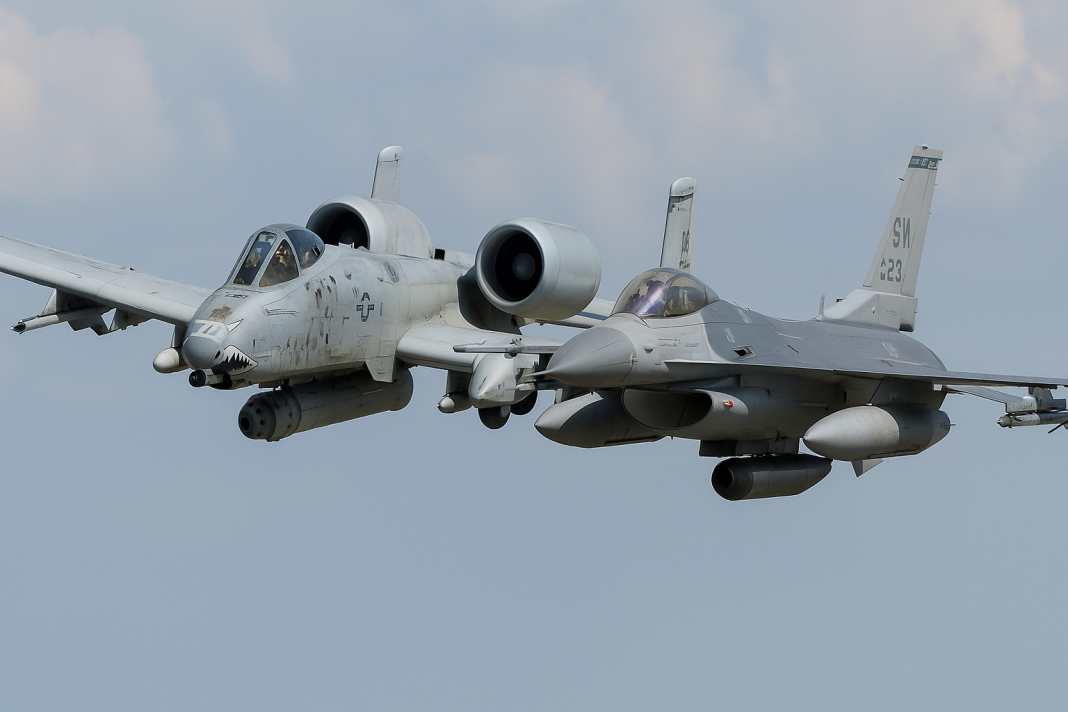In the late 1980s, the U.S. Air Force faced a serious question — could its famous A-10 Thunderbolt II, nicknamed the “Warthog,” survive in modern combat?
The A-10 was a slow and heavily armed aircraft, built to fly low and provide close support for troops on the ground. Its most powerful weapon was the massive GAU-8 Avenger, a 30mm rotary cannon capable of firing 70 rounds per second. This gun could tear through tank armor, but the aircraft carrying it was vulnerable to enemy air defenses.
To solve this problem, the Air Force came up with an unusual idea: take the speed and agility of the F-16 Fighting Falcon, a nimble fighter jet, and give it the Warthog’s legendary firepower. The hope was that a faster jet could deliver the same devastating gun runs while being harder for enemies to hit.
The plan was called the A-16 project, later updated as the F/A-16 concept. Engineers designed a special gun pod, known as the GBU-5, to hold a lighter version of the Warthog’s cannon, the GAU-13/A. This four-barrel weapon could fire 40 rounds per second. Additional miniguns were planned under the wings, along with advanced targeting systems.
It seemed like a smart solution — at least on paper. The Air Force even modified F-16s and deployed them for testing in Operation Desert Storm.
Combat Trials Reveal Major Problems
During the Gulf War in 1991, 24 F-16 aircraft were fitted with the new gun pods and sent into battle. The mission was clear: test whether this high-speed alternative could replace the A-10 in close air support missions.
The results came quickly, and they were disappointing. The gun pods proved difficult to keep steady. Just a second or two of firing could knock them off-center, making accurate targeting nearly impossible.
There was another problem — speed. The A-10 typically approached targets at about 335 miles per hour, giving its pilots enough time to aim precisely. The F-16 was almost twice as fast, cruising at nearly 600 miles per hour. That speed made it harder to line up a target before the aircraft had already passed over it.
The weapon’s vibrations were also a concern. Firing the 30mm cannon shook the aircraft so violently that engineers worried about possible damage to electronics.
Within two days of combat operations, pilots stopped using the gun for precision attacks. Instead, they tried firing in a more general direction, using the rounds for area damage rather than pinpoint strikes. This was far from the original goal.
Realizing the experiment was not working, the Air Force removed the gun pods and returned the jets to their regular bombing missions.
Why the A-10 Remained Irreplaceable
The failure of the A-16 and F/A-16 programs highlighted why the A-10 was unique.
The Warthog was designed from the ground up to survive heavy fire while delivering deadly accuracy. Its cockpit was protected by titanium armor. Its engines were placed high to avoid debris damage. Its fuel tanks could seal themselves after being hit. Even if it lost part of a wing or tail, it could still fly home.
Most importantly, the entire aircraft was built around its massive gun. The GAU-8 was mounted along the centerline of the A-10, perfectly balanced for stability during firing. The jet’s slower speed was not a flaw in its mission — it was necessary for making precise attacks on ground targets.
During the Cold War, the A-10’s role was clear: stop enemy tanks, even if it meant taking losses. It was never expected to be completely safe in battle. But it could deliver devastating firepower where it mattered most.
When tested, no other aircraft — not even the faster and more advanced F-16 — could match the A-10’s ability to deliver the cannon’s rounds with accuracy and control.
The Gulf War proved that the A-10 was still the most effective platform for its mission. Even though the Air Force had tried multiple times to retire it, the aircraft continued to serve.

